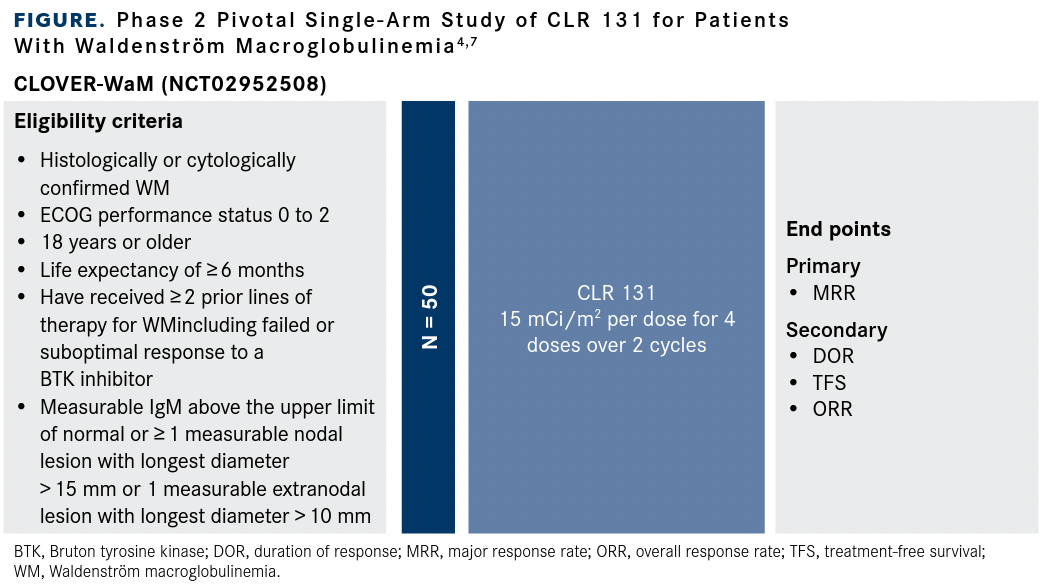Expansion Cohort Explores Efficacy of Novel Treatment for Waldenström Macroglobulinemia
Treatment options for patients with Waldeström macroglobulinemia are often derived from those devel-oped for patients with multiple myeloma and other low-grade lymphomas.
Radhakrishnan Ramchandren, MD

Treatment options for patients with Waldeström macroglobulinemia (WM) are often derived from those developed for patients with multiple myeloma and other low-grade lymphomas. Patients with WM are relatively rare. Their disease is defined as lymphoplasmacytic lymphoma with involvement of the bone marrow and the immunoglobulin (Ig) M monoclonal gammopathy, novel therapeutic strategies are often difficult to develop through traditional clinical trial design.1
“[WM] is a relatively rare malignancy [and] what’s important to know is that even with current therapies—ones we use traditionally including chemotherapy as well as some targeted therapies—this is a disease that’s managed rather than cured,” said Radhakrishnan Ramchandren, MD, chief of the Division of Hematology/Oncology at the University of Tennessee Medical Center in Knoxville. “Another way to put that is that all patients with [WM] tend to relapse. It depends on the timing: Some patients have a longer duration of response to initial or subsequent therapies and other patients have shorter ones, and that’s based on a variety of clinical factors.”
Despite several available therapies for patients in this population, patients progress following first-line standard of care and subsequent treatment with agents such as Bruton tyrosine kinase (BTK) inhibitors that have acknowledged benefit.1 Investigators are exploring this unmet clinical need by focusing on agents that may elicit deep, durable responses with therapies that show early efficacy in patients with [WM].
Early Efficacy With CLR 131
Phospholipid ether/phospholipid drug conjugates (PDC) may offer investigators an avenue for exploration to enhance treatment outcomes for this patient population. The novel small-molecule radiotherapeutic PDC, CLR 131, is designed to deliver cytotoxic radiation to cancer cells and stem cells.2
“[CLR 131] has a very unique mechanism [of action],” Ramchandren said. “CLR 131 uses a radioactive isotope that is attached to a compound that targets the cancer cell. What is unique about doing this is not only the use of radiation, which is not commonly [used for patients with WM], but [also] that the way the mechanism targets the malignant cell is by the selective uptake and retention of phospholipid ethers, which occur more frequently and turnover occurs more frequently in cancer cells [compared with] normal cells.” Specifically, CLR 131 leverages its affinity to lipid rafts, allowing for internalization and delivery of the iodine 131 payload.3
The agent is under investigation in the phase 2 CLOVER-1 study (NCT02952508) in which investigators are evaluating its safety and efficacy in patients with select B-cell malignancies including multiple myeloma, indolent chronic lymphocytic leukemia, small lymphocytic leukemia, lymphoplasmacytic lymphoma, marginal zone lymphoma, mantle cell lymphoma, diffuse large B-cell lymphoma, central nervous system lymphoma, and WM who have been previously treated with standard therapy.4 The study included 6 efficacy-evaluable patients with WM who had a median age of 69 years (range, 54-81), a median of 2 prior regimens (range, 1-5), and most patients (4/6) had high-risk disease; 1 patient each had intermediate-risk and low-risk disease.3 CLR 131 was administered in up to 4 intravenous infusions, each lasting approximately 15 to 20 minutes, over the course of 3 months. Patients received a mean total body dose of 92.76 mCi CLR 131.
As of the January 8, 2021, data cutoff, the overall response rate (ORR) was 100%, which included 1 complete response, 4 partial responses, and 1 major response.3 The median time to initial response was 48 days and the median duration of response (DOR) and treatment-free remission (TFR) have not been reached. Investigators reported that the mean going DOR was 335 days and the mean TFR was 384 days.
“The ORR of 100% is very exciting and uncommon [for patients who have] relapsed after multiple treatments,” Ramchandren said. “What is most exciting about these data that came out regarding this agent at the [2021] American Society of Clinical Oncology Annual Meeting is that [even though] this [study] looked at a relatively small number of patients with this disease, these patients have been heavily pretreated [with] prior regimens and have largely had resistance or suboptimal responses to existing therapies,” Ramchandren said. “A very high proportion of this small population responded to the therapy despite having difficulty responding to their prior therapies or their current therapy coming into this [study].”
Common treatment-emergent adverse effects of any grade included thrombocytopenia (100%), neutropenia (83%), and anemia (66%) No cases of bleeding or febrile neutropenia were observed. All patients who experienced cytopenias recovered and the median time to resolution was 21 days.3
Ramchandren noted that these patients were also evaluated for efficacy by their molecular profiles. Patients with certain genomic alterations including MYD88 wildtype and CXCR4 wild-type disease have limited response to conventional therapies such as the BTK inhibitor ibrutinib (Imbruvica) with reported median progression-free survival (PFS) of 4.8 months in data from a phase 2 study (NCT01614821).1,5
Three of the 6 patients evaluated in CLOVER-1 had MYD88 wild-type disease and 2 of these patients were also CXCR4 wild type. The major response rate was 100% for these patients and the individual who had MYD88 wild-type disease (CXCR4 status unknown) had a complete response to treatment with CLR 131. All patients with MYD88 wild-type disease exceeded 8.5 months of follow-up and had an average TFR of 18.1 months; the median PFS was not reached.3
Investigators reported significant responses in the few patients enrolled in the trial with WM classification, leading Cellectar Biosciences, the developer of the agent, to meet with the FDA and initiate a single-arm expansion cohort of CLOVER-1 for patients with WM.2 Prior to this meeting the agent was granted fast-track designation for this patient population in May 2020 based on earlier findings from CLOVER-1.6
CLOVER-WaM Looks To Expand Treatment Options
The phase 2 pivotal cohort was initiated by Cellectar following a Type C guidance meeting with the FDA.2 “[The CLOVER-1 data are] very intriguing and obviously very early, but it led to the desire to look at [CLR 131] in a larger number of patients and thus the expansion cohort we’re speaking of [was initiated],” Ramchandren explained.
CLOVER-WaM is a pivotal expansion cohort that will evaluate the efficacy of CLR 131 in adult patients with WM who have received at least 2 prior lines of therapy, including those who have had a suboptimal response or failed treatment with a BTK inhibitor (FIGURE4,7). Patients will receive a total of 4 infusions of CLR 131 (15 mCi/m2) over the course of 2 cycles. Each cycle will last approximately 57 days.7
FIGURE. Phase 2 Pivotal Single-Arm Study of CLR 131 for Patients With Waldenström Macroglobulinemia4,7

“CLR 131 is given intravenously on 4 occasions [with patients receiving] the infusion on day 1, day 15, day 57, and day 71,” Ramchandren said. “Compared with other treatments, there are [fewer] infusions and they’re more spread apart and it is of course something that we will need to watch closely as part of a clinical trial. There will be additional visits for safety and efficacy that go into [the trial design].”
CLOVER-WaM will enroll 50 patients and investigators will assess the first 10 for futility and safety. The primary end point is major response rate. Secondary end points include ORR, TFS, DOR, and clinical benefit rate.4,7
To be eligible, patients must have measurable IgM above the upper limit of normal, at least 1 measurable nodal lesion with the longest diameter greater than 15 mm, or 1 measurable extranodal lesion with the longest diameter over 10 mm.4 Patients who have undergone transplant must be 3 years out from the procedure.
Patients with a need for acute treatment of WM and those receiving anticancer therapy within 2 weeks of initial CLR 131 infusion are not eligible for the trial. Patients who have undergone prior total body or hemibody irradiation and those with prior external-beam radiotherapy resulting in greater than 20% of total bone marrow receiving greater than 20 Gy will also be excluded. Patients with secondary malignancies requiring therapy within the last 2 years or not in remission will generally be excluded, except in patients with successfully treated nonmetastatic basal cell/squamous cell skin carcinoma or prostate cancer not requiring therapy.4 Enrollment is expected to take 18 months and is under way in the United States, Europe, and Australia.7
References
- Grimont CN, Castillo Almeida NE, Gertz MA. Current and emerging treatments for Waldenström macroglobulinemia. Acta Haematol. 2021;144(2):146-157. doi:10.1159/000509286
- CLR 131. Cellectar Biosciences. Accessed November 18, 2021. bit.ly/3xibzIj
- Ailawadhi S, Chanan-Khan AAA, Peterson JL, et al. Treatment free remission (TFR) and overall response rate (ORR) results in patients with relapsed/refractory Waldenstrom’s macroglobulinemia (WM) treated with CLR 131. J Clin Oncol. 2021;39(suppl 15):7561. doi:10.1200/JCO.2021.39.15_suppl.7561
- Study of CLR 131 in select B-cell malignancies (CLOVER-1) and pivotal expansion in Waldenstrom macroglobulinemia (CLOVER-WaM). ClinicalTrials.gov. Updated October 4, 2021. Accessed November 18, 2021. https://clinicaltrials.gov/ ct2/show/NCT02952508
- Treon SP, Meid K, Gustine J, et al. Long-term follow-up of ibrutinib monotherapy in symptomatic, previously treated patients with Waldenström macroglobulinemia. J Clin Oncol. 2021;39(6):565-575. doi:10.1200/JCO.20.00555
- Cellectar receives FDA fast track designation for CLR 131 in lymphoplasmacytic lymphoma/Waldenstrom’s macroglobulinemia. News release. Cellectar Biosciences. May 26, 2020. Accessed November 18, 2021. bit.ly/3xkvN4a
- Ailawadhi S, Chanan-Khan A, Peterson J, et al. An open-label, multicenter, phase II study of CLR 131 in patients with relapsed or refractory (R/R) select B-cell malignancies (CLOVER-1) and expansion cohort in patients with waldenstrom macroglobulinemia (CLOVER-WaM). Ann Oncol. 2021;32(suppl 5):S784-S785. doi:10.1016/j.annonc.2021.08.150




